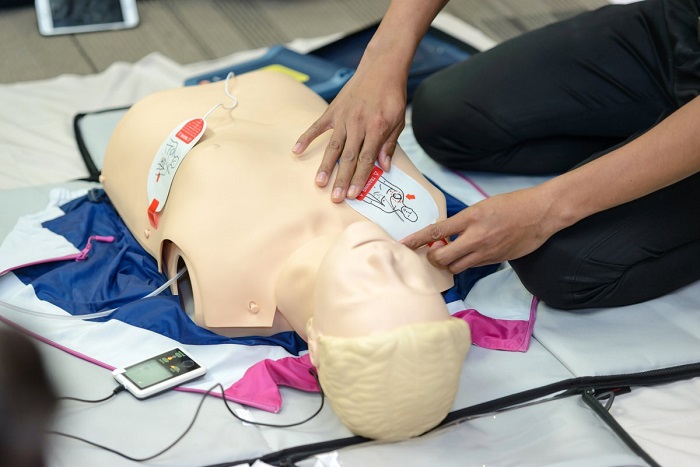Heart Health: How To Use An AED

An automated external defibrillator (AED) is a portable device that delivers an electric shock through the chest to the heart. An AED is most commonly used when someone experiences sudden cardiac arrest or an irregular heartbeat and the shock allows a normal rhythm to resume. When the heart isn’t beating correctly, oxygen isn’t flowing through the body like it needs to. If not treated within minutes, it quickly leads to death. A victim’s chance of surviving cardiac arrest drops by ten percent for every minute that a normal heartbeat isn’t restored, which is why speed to treatment is so important.
Cardiac arrest can happen anywhere, and it’s important to act quickly to increase a person’s chance of survival. If someone around you collapses and doesn’t respond when you call or shake him or her, have someone call 911 immediately and begin CPR. Local emergency services can help guide you while they are on their way. If an AED is available, use it as soon as you can. If there are other rescuers around, have one continue to administer CPR while another prepares the AED. These automated devices are user-friendly and guide untrained bystanders through the process of using it. To use an AED:
- Make sure the person is in a dry area and that their chest is completely dry.
- Attach the sticky pads to the person’s chest. Most will have a diagram that shows where to place them, but one should be on the right center of the person's chest above the nipple and the other pad slightly below the other nipple and to the left of the ribcage.
- Plug the pads into the machine.
- Turn the machine on and wait for commands.
- Stop CPR and do not touch the person as the machine analyzes the heart rhythm. If no shock is required, continue performing CPR until help arrives.
- If a shock is recommended, a recorded voice will prompt the rescuer to press the shock button on the AED. Make sure no one is touching the victim before administering the shock. This shock momentarily stuns the heart and stops all activity. It gives the heart the chance to resume beating effectively.
- After a shock is administered, resume CPR. The AED will beep to the rhythm of compressions for about two minutes, then it will reanalyze.
- Continue until emergency services arrive to take over.
Standard AED pads are designed for ages eight and above. For children younger than eight, detach the lower pad from the other and place it on the child’s back. There isn’t enough space on a child’s chest to place the pads on either side of the heart without them touching, so moving one pad to the back is necessary. Never place the pads on top of each other.
Non-medical personnel do not need training to use an AED, but formal training in CPR and AEDs can make a bystander feel more comfortable and confident when the time comes. The American Heart Association offers CPR and AED training through training centers. To locate a training center near you, call your nearest AHA office or 1-888-AHA-4CPR. You may also visit heart.org/cpr.
Story Credit: http://myfox8.com/2018/02/09/heart-health-how-to-use-an-aed/


